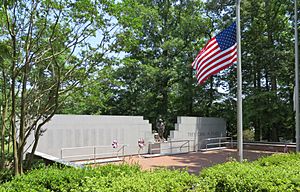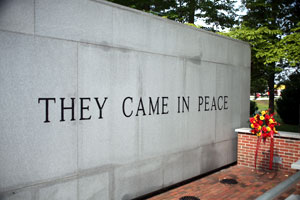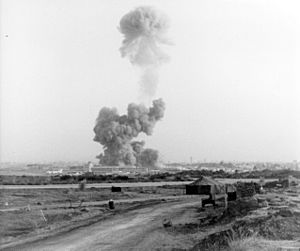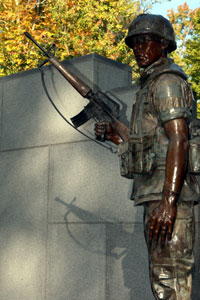Beirut Memorial facts for kids
The Beirut Memorial honors 241 American peacekeepers. These brave people included 220 Marines, 18 sailors, and three soldiers. They died in a terrible attack on October 23, 1983, in Beirut, Lebanon. The memorial is located in Jacksonville, North Carolina. It stands near Camp Gilbert H. Johnson, which is part of Marine Corps Base Camp Lejeune. Every year, a special ceremony is held here to remember those who lost their lives in the attack.
Contents
The 1983 Beirut Bombing
In the summer of 1982, the United States sent military forces to Lebanon. They went there to help keep the peace between different groups. On March 24, 1983, a group of Marines from Camp Lejeune, North Carolina, also went to Beirut. They joined French and Italian forces.
At first, the forces helped bring some calm. But over time, some groups in Lebanon started to see the Marines as enemies. This led to attacks on the Marine positions. On October 23, 1983, a truck full of explosives drove into the building where the First Battalion, 8th Marines had its headquarters. The truck had been seen before, so it didn't cause alarm. The huge explosion destroyed the building. This attack killed 241 American Marines, Sailors, and Soldiers.
How the Memorial Started
After the 1983 attack, people in Jacksonville, North Carolina, wanted to remember the peacekeepers. The city's Beautification and Appearance Commission had a plan to plant trees as a "living memorial." They decided to plant more trees along Lejeune Boulevard, a road leading to the Marine Corps Base.
News of this plan spread across the country. Many people sent donations to help. This support was seen as the start of the Beirut Memorial. As more money came in, Camp Lejeune offered a special piece of land. This land was easy to see and reach, perfect for a memorial.
Designing the Memorial
Once the land was offered, a design contest began. Students from North Carolina State University's School of Design shared their ideas. Two students' designs were chosen. They worked together to create the final plan.
The memorial design includes two broken walls. These walls remind us of the building destroyed in the bombing. Between the walls is a stand for a statue. The memorial was officially opened on October 23, 1986. The bronze statue was added later, on October 22, 1988. It was created by Abbé Godwin, an artist who also made North Carolina's Vietnam Memorial.
A copy of the statue was made for the National Fleet Reserve Associated Headquarters in Virginia. Smaller copies were also made. These help raise money for scholarships for military families.
Later, families of the Beirut victims asked for a poem to be added. The poem is called "The Other Wall" by Robert A. Gannon. Its words were carved in bronze and added to the memorial in 1991.
The memorial also has the words "THEY CAME IN PEACE." It lists 273 names. These include those who died in the attack and those who later died from their injuries. It also lists three Marine Corps pilots from the Jacksonville area. They died in a rescue mission in Grenada in 1983. The words "They came in peace" were chosen because survivors used them on a makeshift memorial in Beirut.
Remembering with Ceremonies
Every year, ceremonies are held at the Beirut Memorial. These usually happen around the date of the attack. At the 25th anniversary ceremony in 2011, a plaque was added. It honors the Gold Star Mothers. These are mothers who have lost a child serving in the military.
Other ceremonies also take place at different memorials. For example, a wreath-laying ceremony was held in Florida. An annual Beirut Remembrance Day ceremony has been held in Phoenix, Arizona, since 2008.
Other Ways to Remember
There is a Beirut Memorial Room at the USO in Jacksonville, North Carolina. It has a wall with the names of all those who died. It also includes the words "They Came in Peace."
At the Armed Forces Chaplaincy Center in South Carolina, you can see a partially destroyed sign. This sign is from the Beirut barracks chapel. It reminds people of those who died. A chaplain who was there said the sign showed "Peace-keeping" clearly, but the bottom was destroyed. This showed the idea of peace above and the reality of war below.
Other memorials have been built across the United States. These include memorials in Philadelphia, Pennsylvania, and Florida. A special Lebanese cedar tree was planted in Arlington National Cemetery. It is near the graves of some victims. A plaque in front of the tree says, "Let peace take root." It remembers the Americans killed in Beirut and all victims of terrorism. The National Museum of the Marine Corps in Virginia also has an exhibit about the attack.
Outside the U.S., there is a memorial park in Haifa, Israel. It has 241 olive trees, one for each American who died. These trees lead to a viewpoint on Mount Carmel that looks toward Beirut.
A Memorial Postage Stamp
People are working to create a special postage stamp to remember the victims. They want the United States Postal Service to approve it. While waiting, Beirut veterans have made their own "PC Postage" stamp. This stamp shows the Beirut Memorial statue. It is approved for use as postage. Selling these stamps also helps raise money for the Gold Star Mothers Memorial Foundation.






